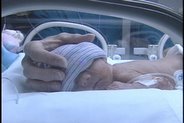skip to main |
skip to sidebar
 The concept of airborne disease transmission was well accepted in the early to mid 1900's. It was frequent that you would see UV lights in hospital wards for upper air disinfection. UV lights were a standard form of infection control in TB wards.But then times changed. Aggressive measures helped to eradicate TB from our country. Drugs such as vaccines proved effective and immediate. Hospitals, like all buildings, began to have ventilation to exhaust contaminated air while bringing in fresh air. Scientists and researchers turned away from studying airborne transmission and moved on to newer issues.
The concept of airborne disease transmission was well accepted in the early to mid 1900's. It was frequent that you would see UV lights in hospital wards for upper air disinfection. UV lights were a standard form of infection control in TB wards.But then times changed. Aggressive measures helped to eradicate TB from our country. Drugs such as vaccines proved effective and immediate. Hospitals, like all buildings, began to have ventilation to exhaust contaminated air while bringing in fresh air. Scientists and researchers turned away from studying airborne transmission and moved on to newer issues.
Since the advent of SARS, pandemic influenza and a resurgence in TB, scientists are once again turning their attention to airborne transmission. We've prepared a new white paper that examines some of the findings of these new studies. Like all good research it answers some questions and raises some more! Hopefully this spark new interest in studying airborne transmission.
 Readers here know that we discuss the germicidal aspects of Ultraviolet Irradiation. We know that a specific wavelength of UV damages a microorganism's DNA, which neutralizes the pathogen. We also know that UV does this pretty quickly from lab experiments and published papers. But now we know just how fast it takes.Researchers have now clocked the effects of UV on DNA in real time. It turns out UV does its work in less than a picosecond.For more on what a picosecond is, and what this development means to scientist, check out this link to Science A-go-go. It's a great site for science with a little twist!
Readers here know that we discuss the germicidal aspects of Ultraviolet Irradiation. We know that a specific wavelength of UV damages a microorganism's DNA, which neutralizes the pathogen. We also know that UV does this pretty quickly from lab experiments and published papers. But now we know just how fast it takes.Researchers have now clocked the effects of UV on DNA in real time. It turns out UV does its work in less than a picosecond.For more on what a picosecond is, and what this development means to scientist, check out this link to Science A-go-go. It's a great site for science with a little twist!
Multi and Extreme Drug Resistrant TB strains are ravaging parts of Africa, mainly preying upon HIV+ patients whose immune systems are weakened. While TB was nearly eradicated from Western countries, it is a serioud health threat elsewhere, especially in South Africa.
Because TB is airborne, UVGI systems are an effective way to stop transmission of the disease. The article below mentions how UV is used in a new TB unit in a hospital about 2 hours north of Pretoria.
The Minister of Health, Dr Manto Tshabalala-Msimang and Limpopo Health MEC Seaparo Sekoati visited a newly upgraded Tuberculosis (TB) unit at the FH Odendaal Hospital in the town of Modimolle in Limpopo today.
The visit comes after the Department of Health spent about R2, 5 million to upgrade the unit to accommodate more drug-resistant TB patients.
The unit is designed to prevent hospital acquired TB infection and improves patient care and treatment outcomes.
The hospital has 38 beds, 17 Multi-Drug (MDR) TB patients and three Extreme Drug Resistant (XDR) TB patients are accommodated in the hospital.
The unit is fitted with extractor fans and ultraviolet light filters which remove and kill bacteria and thereby prevent cross infection in the hospital.
"For extra protection, respirator masks are issued to all health workers and visitors in the hospital and patients are provided with surgical masks," Dr Tshabalala-Msimang.
She said MDR TB Units are being improved countrywide to deal with infection control.
UV systems were routinely used in this country to treat TB, starting in the 1930's. As more effective drugs were crafted, and TB's threat waned in the US, so did the use of UV in hospitals. It now appears that UV technology is once again needed to help stop the TB killer from spreading.
 Arthur S. Hughes knows a thing or two about terrorism, national security and airborne pathogens. To start, he served in the Navy during the Vietnam era. Now he is a Master Sergeant in the National Guard's 128th Chemical Company and is a PA (Physician's Assistant). In his civilian life he works for the New Jersey Department of Environmental Protection.
Arthur S. Hughes knows a thing or two about terrorism, national security and airborne pathogens. To start, he served in the Navy during the Vietnam era. Now he is a Master Sergeant in the National Guard's 128th Chemical Company and is a PA (Physician's Assistant). In his civilian life he works for the New Jersey Department of Environmental Protection.
So, when it comes to biodefense, he's got the credentials!
In the most recent issue of the journal Army Chemical Review, Master Sergeant Hughes provide a neat overview of what Ultraviolet Germicidal Irradiation (UVGI) is, and how it can help protect buildings from attack. To read the article, click here.
To find archive issues of Army Chemical Review, click here.
In researching this article, I discovered that the Army has several publications that are available for us civilians. The list is extensive and interesting, whether you're researching the latest in defense technology or interested in military history. In typical Army creative style, the library is called the Army Professional Writing Collection and can be found here.




